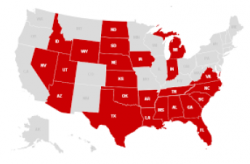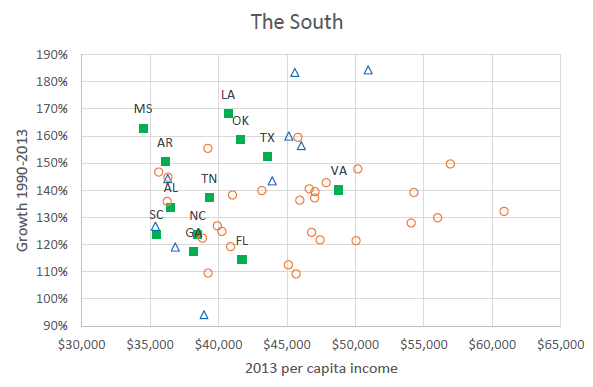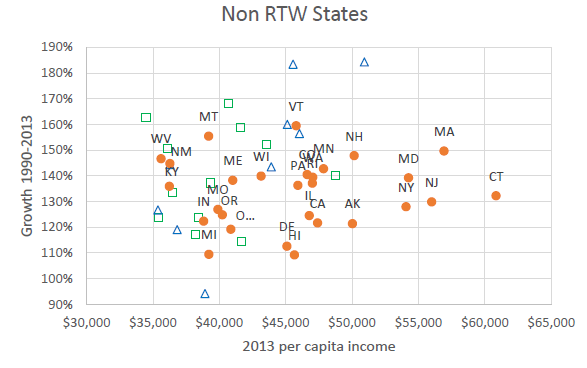The Bogus Claims on Right to Work
Serious researchers on impact offer many caveats, which advocates blithely ignore.
When it comes to research on the economic effects of “right to work” (RTW) laws, there are two kinds. One is serious academic research; the other is advocacy research. They have nothing in common.
RTW refers to state laws that prohibit companies from signing contracts that require employees to pay a share of the cost of union representatives. Ironically they place conservatives in the odd position of arguing for more government intervention in the private sector.
Serious academic research aims at isolating the effects of RTW from the many other differences among states. It generally takes one of three forms:
Analyzing economic changes following a state’s adoption of RTW. This assumes that other factors in the state don’t change. Opportunities for this kind of study have been limited by the small number of states that adopted such laws recently. Most of the laws were passed in 1947— or shortly afterwards–when the Taft-Hartley act allowed states to ban so-called “union-security” agreements that required unionized workers to contribute to unions. Other than Michigan and Indiana, which I discuss in a previous article, the most recent states to pass RTW legislation were Oklahoma (2001) and Idaho (1986).
Comparing the number of manufacturing facilities in counties along the border between states with RTW and those without.
Building bigger and bigger regression models in hopes of separating all the other factors besides RTW that might affect a state’s economy.
One mark of the serious studies is they come with caveats. As the author of research comparing counties in states with RTW laws with their neighbors across the state line cautioned, “Right-to-Work states historically have pursued a number of other smokestack-chasing policies, such as low taxes, aggressive subsidies, and even, in some cases, lax environmental regulations.” As another example, the authors of a major analysis of Idaho before and after RTW passage report that union membership declined and manufacturing growth accelerated compared to its neighbors. However, they add “we are cautious, however, in associating the increase in manufacturing growth with the passage of the law.” Similar cautions appear in the other academic research papers.
A report from the nonpartisan Congressional Research Service summarizes the situation:
National RTW proposals are often discussed in the context of the economic performance of states that have adopted them. However, research that compares outcomes in RTW and union security states is inconclusive…
- Unionization rates in RTW states are less than half of what they are in union security states. It is ambiguous what portion of this difference is attributable to RTW laws and what portion is due to diverse preferences among the states regarding unionization.
- In the past decade, aggregate employment in RTW states has increased modestly while employment in union security states has declined. It is unclear if this growth is attributable to RTW, other pro-business policies (which tend to be concentrated in RTW states), or other factors.
- Wages are lower in RTW states than in union security states. Historical research has suggested that RTW laws have little influence on these differences. More contemporary scholarship has come to diverse conclusions, depending on the researchers’ methodology.
Difficulties associated with rigorously studying the relationships between RTW laws and various outcomes are likely to continue to make it difficult to generate definitive findings about these relationships. As such, the ongoing debate on RTW may be driven by factors other than rigorous empirical evidence.
A glance at the map above suggests one problem with trying to separate the effect of RTW laws from other quirks of the states. The distribution (red states have passed RTW laws) does not look like one you’d expect if states were chosen using random sampling. RTW states are found in the South, the Great Plains and Rocky Mountains. None are on the West Coast, the Northeast, or, until the recent passage in Indiana and Michigan, the industrial Midwest.
Because the economies of the southern states have been so different from RTW states in the West, I will look at the two groups separately.
The South
In 1947, when most southern states adopted RTW laws, most had legally required segregation. Since then the legal segregation edifice was dismantled, allowing these states to more fully participate in the national economy. In many southern states, desegregation was accompanied by increased investments in education.
The chart on the right shows the average 2013 per capita income for the southern states (in green) on the horizontal scale. The growth in per capita income from 1990 is shown on the horizontal scale. (The circles are the non-RTW states and triangles are for the western RTW states. These are shown in detail on the later graphs.)
Despite their growth in per capita income, southern states are still at the low end for this among all states and still seem to be playing catchup.
The Plains and Mountain RTW States
This is the group that is most diverse economically. At one extreme is North Dakota which has seen huge growth in incomes stemming from its Bakken oil fields (requiring a much larger vertical scale on the graph). At the other end is Nevada which saw a decline in per capita income (these are in nominal dollars meaning the real decline was much worse).
States in this region generally have small populations and are often dominated by one or two industries, making their results volatile. Several that have done well historically are in danger due to declining oil prices.
The Non-RTW States
As a group, these states have somewhat higher income but lower growth than either group of RTW states. It is perhaps telling that Indiana and Michigan, the two states that recently adopted RTW, are at the low end of the non-RTW states in average income and the growth of income.
Other statistical measures support these generalizations. Southern states have the lowest mean income and the lowest standard deviation suggesting that there is a commonality among them. The Western RTW states have the highest growth and the highest standard deviation of growth, reflecting their volatility. (I did not weight these calculations by populations). The southern RTW states are growing faster than the non-RTW states, but at the present rate it would take 50 years for the southern states to catch up in income.
Caveats that researchers include in their examination of the individual states both suggest that one should be very cautious in predicting the effect of RTW laws.
This caution is not shared by the advocacy studies issued by conservative think tanks in states considering RTW legislation. A report titled Right to Work is Right for Oregon is typical of the genre. It includes an annotated bibliography of some of the major RTW research (mixing in several advocacy pieces) and even includes some of the cautions the authors of these papers expressed.
Yet when it comes to predicting the effect of RTW legislation on Oregon the report’s authors throw caution to the winds. Among their many claims is that Oregon would have 110,000 more people working in 2021 if it became a RTW state. While they are vague on their methodology they seem to have arrived at this conclusion by comparing the average growth rates over the past 70 years of RTW states with states without RTW.
Similar reports have been issued by conservative think tanks in other states considering RTW, including Indiana and Oklahoma. We should anticipate one for Wisconsin laying out with great certainty the number of additional jobs we can count on if RTW is passed in Wisconsin. You might think the failure of Scott Walker’s promise to add 250,000 jobs in his first term would bring about more caution in bold predictions, but that doesn’t seem to be happening.
A taste of what we can expect as Wisconsin heats up is found in a recent op ed by Scott Manley of Wisconsin Manufacturers and Commerce in the Milwaukee Journal Sentinel. Manley starts out by invoking the freedom argument, ignoring the fact that, whatever its merits, RTW represents a government restriction on contracts between private parties. He then cites comparative growth figures between RTW and non-RTW states, without ever mentioning the issue of causality. Next he claims that effective wages are actually higher in RTW states. His authority for this claim is something called the National Institute for Labor Relations Research. Despite its very neutral-sounding name the group exists for the sole purpose of promoting RTW; its web site describes it as “a non-profit research facility analyzing and exposing the inequities of compulsory unionism.”
The WMC seems much less motivated by what is good for Wisconsin’s economy than pure ideology.
Data Wonk
-
Why Absentee Ballot Drop Boxes Are Now Legal
 Jul 17th, 2024 by Bruce Thompson
Jul 17th, 2024 by Bruce Thompson
-
The Imperial Legislature Is Shot Down
 Jul 10th, 2024 by Bruce Thompson
Jul 10th, 2024 by Bruce Thompson
-
Counting the Lies By Trump
 Jul 3rd, 2024 by Bruce Thompson
Jul 3rd, 2024 by Bruce Thompson
























Did I miss something or did you fail to compare wages to cost of living in the RTW states?
Many businesses owners and managers would like nothing better than an ignorant working class population that is ill-informed, desperate and powerless without a voice. At the same time a business nonprofit organization like WMC can act as an agent manipulating politicians for favorable treatment with legislation and more laws from ALEC written by corporations. All working citizens can then be treated as a disposable commodity serving the pure profit motives of business and working in declining working conditions, benefits and wages. It really does not matter if you are a management employee or worker being supervised, the outcome is the same for the majority of people working for a living.
Welcome to Wisconsin’s version of 21st Century fascism.
RTW will not bring about a momentous change. After all of the arguments are done, not including Ciepulch’s funny diatribe, it comes down to freedom of the individual and that the growth in jobs has been in RTW states.
As a member of several unions over the years, and the target of many, years back, there has been serious questions on corruption and misuse of power. We seldom see strikes these days as employees realize that you cannot price your self out of the market, as the Briggs unions wanted to do.
In some unions we saw that if you give people a little power they misuse it just as we have seen local leaders like the idiotic County board misuses the little power that they have.
Time has destroyed the unions as people are more educated, more mobile and smarter about where to work. The old foundries and bad facilities just do not exist as society moved on.
The main reason we had to clamp down on the public unions was that they misused their power to leverage salaries, benefits, vacations, health, dental, pensions way above where the general populace was at that time. Public employees should not do better than the public in general.
Being the hot topic so far this year, I’ve done a lot more reading on this subject. After looking at a decent number of peer reviewed studies and reading papers from both opponents and supporters, I haven’t found enough evidence to compel anyone to change their mind. My general impression is that there are small benefits from RTW, especially when paired with other business friendly laws. However, as discussed, they tend to come with caveats and complications.
With that said, people who are strong supporters of unions will never be compelled to change their minds based on those small benefits. Some of the biggest impacts of RTW laws, for example having a strong impact on the percent of workers who are contractors instead of full time employees (the difference between benefits and no benefits) won’t overcome things like the fear of work places suddenly becoming unsafe and wages being slashed in half.
The benefits/draw backs are so complicated and minuscule that to me it comes down to my beliefs on personal freedom. Who gets to decide that the Unions are the perfect solution for everyone? Why must someone be forced to join an organization they disagree with? How can the same people have so much trust in government protecting people in some areas, but in the next debate they demand strong unions to protect people (I’m presuming because the government can’t?). This isn’t the early 1900’s anymore, unions hurt their own causes just as much as they help these days. And things like unsafe work environments and discrimination are now on the law books and covered by government entities far better than any union.
If the unions are so great for workers, they’ll obviously still survive after any RTW legislation. People will see the benefits, and if it’s worth it to them, they’ll still join. If they don’t see the benefits, or outright disagree with the organization, we shouldn’t force them to join.
PJ-on average, wages are about 6% higher in non-RTW states (treating each state equally rather than weighting by population). Again, it is important to avoid the statistical fallacy of assuming the difference is caused by RTW.
AG brings up an interesting point about RTW — the usefulness of unions when we have all these workplace protection laws on the books — such thinking neglects the fact that the presence of unions is one of the factors that KEEPS those protections in place. Remove unions and you can bet good money the same lobbyists will turn to the next task of dismantling those laws.
I prefer to think of South Carolina when I think of RTW. An eternally poor state that often leads the nation in high unemployment, ranking at or near the top. South Carolina got mugged coming and going in the rise of The New South, In the space of two decades it benefitted greatly from the exodus of the textile industry from New England. In less than a generation it lost those jobs to low-wage Mexico, which lost those jobs to Guatamala, Honduras, Vietnam…anywhere where people will work for pennies an hour, no bathroom breaks and the occasional Triangle Shirtwaist fire. If a race to the bottom is what you want, RTW is a great place to start.
Another statistical fog that can’t be factored in easily is to compare RTW to non-RTW and the demographic population shift to the South and Southwest, similar to the exodus to the suburbs for metro areas. Weirdly, the biggest chunk of the GDP still comes from those unionized states of the Northeast Quadrant, which includes Illinois and Wisconsin.